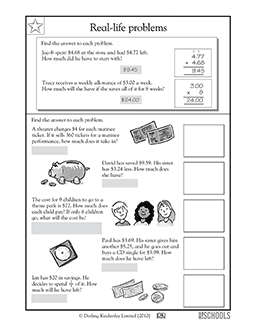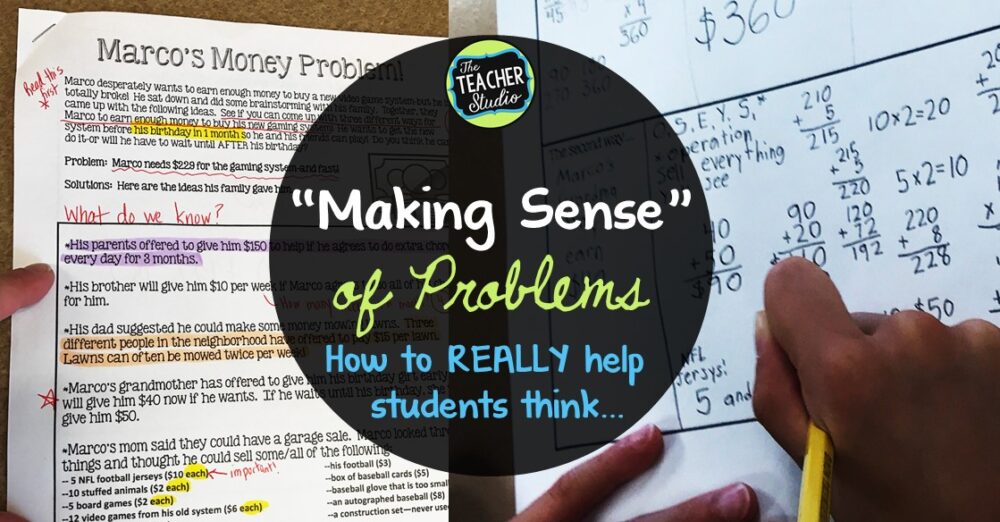Index of lessons |
Real-World Money Word Problems Worksheet These word problems require some fancy counting skills. Students will identify the amounts created with mixed sets of coins. They’ll compare number amounts and answer questions about what it would take for the person in the problem to afford their goals.
'Investment' Word Problems (page 1 of 2)
Investment problems usually involve simple annual interest (as opposed to compounded interest), using the interest formula I = Prt, where I stands for the interest on the original investment, P stands for the amount of the original investment (called the 'principal'), r is the interest rate (expressed in decimal form), and t is the time.
For annual interest, the time t must be in years. If they give you a time of, say, nine months, you must first convert this to9/12 = 3/4 = 0.75 years. Otherwise, you'll get the wrong answer. The time units must match the interest-rate units. If you got a loan from your friendly neighborhood loan shark, where the interest rate is monthly, rather than yearly, then your time must be measured in terms of months.

Investment word problems are not generally terribly realistic; in 'real life', interest is pretty much always compounded somehow, and investments are not generally all for whole numbers of years. But you'll get to more 'practical' stuff later; this is just warm-up, to prepare you for later.
In all cases of these problems, you will want to substitute all known information into the 'I = Prt' equation, and then solve for whatever is left.
- You put $1000 into an investment yielding 6% annual interest; you left the money in for two years. How much interest do you get at the end of those two years?

In this case,P = $1000, r = 0.06 (because I have to convert the percent to decimal form), and the time is t = 2. Substituting, I get:
I = (1000)(0.06)(2) = 120
I will get $120 in interest.
Advertisement
Another example would be:
Real World Problem Math
- You invested $500 and received $650 after three years. What had been the interest rate?
For this exercise, I first need to find the amount of the interest. Since interest is added to the principal, and since P = $500, thenI = $650 – 500 = $150. The time is t = 3. Substituting all of these values into the simple-interest formula, I get:
150 = (500)(r)(3)
150 = 1500r
150/1500 = r = 0.10
Of course, I need to remember to convert this decimal to a percentage.
I was getting 10% interest.
The hard part comes when the exercises involve multiple investments. But there is a trick to these that makes them fairly easy to handle. Copyright © Elizabeth Stapel 1999-2011 All Rights Reserved
- You have $50,000 to invest, and two funds that you'd like to invest in. The You-Risk-It Fund (Fund Y) yields 14% interest. The Extra-Dull Fund (Fund X) yields 6% interest. Because of college financial-aid implications, you don't think you can afford to earn more than $4,500 in interest income this year. How much should you put in each fund?'
The problem here comes from the fact that I'm splitting that $50,000 in principal into two smaller amounts. Here's how to handle this:
| I | P | r | t | |
| Fund X | ? | ? | 0.06 | 1 |
| Fund Y | ? | ? | 0.14 | 1 |
| total | 4,500 | 50,000 | --- | --- |
How do I fill in for those question marks? I'll start with the principal P. Let's say that I put 'x' dollars into Fund X, and 'y' dollars into Fund Y. Then x + y = 50,000. This doesn't help much, since I only know how to solve equations in one variable. But then I notice that I can solve x + y = 50,000 to get y = $50,000 – x.
THIS TECHNIQUE IS IMPORTANT! The amount in Fund Y is (the total) less (what we've already accounted for in Fund X), or 50,000 – x. You will need this technique, this 'how much is left' construction, in the future, so make sure you understand it now.
| I | P | r | t | |
| Fund X | ? | x | 0.06 | 1 |
| Fund Y | ? | 50,000 – x | 0.14 | 1 |
| total | 4,500 | 50,000 | --- | --- |
Now I will show you why I set up the table like this. By organizing the columns according to the interest formula, I can now multiply across (right to left) and fill in the 'interest' column.
| I | P | r | t | |
| Fund X | 0.06x | x | 0.06 | 1 |
| Fund Y | 0.14(50,000 – x) | 50,000 – x | 0.14 | 1 |
| total | 4,500 | 50,000 | --- | --- |
Since the interest from Fund X and the interest from Fund Y will add up to $4,500, I can add down the 'interest' column, and set this sum equal to the given total interest:
0.06x + 0.14(50,000 – x) = 4,500
0.06x + 7,000 – 0.14x = 4,500
7,000 – 0.08x = 4,500
–0.08x = –2,500
x = 31,250
Then y = 50,000 – 31,250 = 18,750.
I should put $31,250 into Fund X, and $18,750 into Fund Y.
Note that the answer did not involve 'neat' values like '$10,000' or '$35,000'. You should understand that this means that you cannot always expect to be able to use 'guess-n-check' to find your answers. You really do need to know how to do these exercises.
Top | 1 | 2| Return to IndexNext >>

Pictures Of World Money
Real World Money Problems 2nd Grade
Cite this article as: | Stapel, Elizabeth. 'Investment' Word Problems.' Purplemath. Available from |